Chapter 6 Firms and Production
MULTIPLE CHOICE
Choose the one alternative that best completes the statement or answers the question.
1) Economists typically assume that the owners of firms wish to
A) produce efficiently.
B) maximize sales revenues.
C) maximize profits.
D) All of the above.
Answer: C
Diff: 0
Topic: The Ownership and Management of Firms
2) Which of the following statements best describes a production function?
A) the maximum profit generated from given levels of inputs
B) the maximum level of output generated from given levels of inputs
C) all levels of output that can be generated from given levels of inputs
D) all levels of inputs that could produce a given level of output
Answer: B
Diff: 0
Topic: Production
3) With respect to production, the short run is best defined as a time period
A) lasting about six months.
B) lasting about two years.
C) in which all inputs are fixed.
D) in which at least one input is fixed.
Answer: D
Diff: 0
Topic: Production
4) Joey cuts grass during the summer. He owns one lawn mower. For him, the short run is equal to
A) the amount of time it takes to acquire more customers.
B) the amount of time it takes to hire an additional employee.
C) the amount of time it takes to hire an additional employee and buy another lawn mower.
D) the amount of time it takes to mow one lawn.
Answer: C
Diff: 1
Topic: Production
5) Joey cuts grass during the summer. He rents a lawn mower from his dad. Which of the following statements best illustrates the difference between the short run and the long run for Joey?
A) Joey's friends say they will help him, but when he calls them, they say they have other things to do.
B) When Joey acquires more customers, he responds by working more hours. Next year, he will buy a lawn mower and split the work with his brother.
C) Some customers pay Joey immediately; others wait till the following week.
D) Joey has had to turn away some customers because he is already too busy.
Answer: B
Diff: 2
Topic: Production
Figure 6.1

6) Figure 6.1 shows the short-run production function for Albert's Pretzels. The marginal productivity of labor
A) rises then falls as the amount of labor increases.
B) falls then rises as the amount of labor increases.
C) is greater than or equal to the average productivity of labor for all amounts of labor.
D) is less than or equal to the average productivity of labor for all amounts of labor.
Answer: D
Diff: 1
Topic: Short-Run Production
7) Figure 6.1 shows the short-run production function for Albert's Pretzels. The marginal productivity of labor for the third worker is
A) 6.
B) 8.
C) 24.
D) not known from the information provided.
Answer: A
Diff: 0
Topic: Short-Run Production
8) Figure 6.1 shows the short-run production function for Albert's Pretzels. The marginal productivity of labor equals the average productivity of labor
A) for all levels of labor.
B) at none of the levels of labor.
C) only for the first worker.
D) only for the fifth worker.
Answer: C
Diff: 1
Topic: Short-Run Production
9) Figure 6.1 shows the short-run production function for Albert's Pretzels. The law of diminishing marginal productivity
A) appears with the second worker.
B) has not yet appeared for any of the levels of labor.
C) first appears with the fifth worker.
D) is refuted by this evidence.
Answer: A
Diff: 1
Topic: Short-Run Production
10) If the average productivity of labor equals the marginal productivity of labor, then
A) the average productivity of labor is at a maximum.
B) the marginal productivity of labor is at a maximum.
C) Both A and B above.
D) Neither A nor B above.
Answer: A
Diff: 1
Topic: Short-Run Production
11) Average productivity will fall as long as
A) marginal productivity is falling.
B) it exceeds marginal productivity.
C) it is less than marginal productivity.
D) the number of workers is increasing.
Answer: B
Diff: 1
Topic: Short-Run Production
12) If the marginal productivity of labor is constant for all levels of output, then the average productivity of labor
A) is constant.
B) equals the marginal productivity of labor.
C) Both A and B above.
D) Either A or B above but not both.
Answer: C
Diff: 1
Topic: Short-Run Production
13) Joey cuts lawns during the summer. Let q equal the number of acres mowed per day, and let L equal the number of hours worked per day. Joey never works more than eight hours per day, and during that time his short-run production function is q = 0.2 * L. Which of the following statements is FALSE?
A) Joey's marginal productivity equals his average productivity.
B) Joey's marginal productivity diminishes by 0.2 for each additional hour worked.
C) Joey's average productivity is constant.
D) Joey's marginal productivity is constant.
Answer: B
Diff: 1
Topic: Short-Run Production
14) Which of the following statements best summarizes the law of diminishing marginal returns?
A) In the short run, as more labor is hired, output diminishes.
B) In the short run, as more labor is hired, output increases at a diminishing rate.
C) In the short run, the amount of labor a firm will hire diminishes as output increases.
D) As more labor is hired, the length of time that defines the short run diminishes.
Answer: B
Diff: 1
Topic: Short-Run Production
15) Which situation is most likely to exhibit diminishing marginal returns to labor?
Answer: B
Diff: 1
Topic: Short-Run Production
16) Thomas Malthus' prediction of mass starvation resulting from diminishing marginal returns has not been fulfilled because
A) the law of diminishing marginal returns did not hold in this case.
B) Malthus ignored other factors like technological change.
C) relative to Malthus' day, larger percentage of today's labor works in the agricultural sector.
D) All of the above.
Answer: B
Diff: 1
Topic: Short-Run Production
Figure 6.2

17) At Joey's Lawncutting Service, a lawn mower cannot cut grass without a laborer. A laborer cannot cut grass without a lawn mower. Which graph in Figure 6.2 best represents the isoquants for Joey's Lawncutting Service when capital per day is on the vertical axis and labor per day is on the horizontal axis?
A) Graph A
B) Graph B
C) Graph C
D) Graph D
Answer: A
Diff: 1
Topic: Long-Run Production
18) Lectures in microeconomics can be delivered either by an instructor (labor) or a movie (capital) or any combination of both. Each minute of the instructor's time delivers the same amount of information as a minute of the movie. Which graph in Figure 6.2 best represents the isoquants for lectures in microeconomics when capital per day is on the vertical axis and labor per day is on the horizontal axis?
A) Graph A
B) Graph B
C) Graph C
D) Graph D
Answer: C
Diff: 1
Topic: Long-Run Production
19) Which graph in Figure 6.2 represents the isoquants where, as the amount of labor
used increases and the amount of capital used decreases, the marginal product of labor rises when capital per day is on the vertical axis and labor per day is on the horizontal axis?
Answer: D
Diff: 1
Topic: Long-Run Production
20) To say that isoquants are convex is to say that
A) the marginal rate of technical substitution falls as labor increases.
B) capital and labor are perfect substitutes.
C) labor, but not capital, is subject to the law of diminishing marginal returns.
D) there are constant returns to scale.
Answer: A
Diff: 1
Topic: Long-Run Production
21) One way to explain the convexity of isoquants is to say that
A) as labor increases and capital decreases, MPL rises while MPK falls.
B) as labor increases and capital decreases, MPL falls while MPK rises.
C) as labor increases and capital decreases, MPL and MPK both fall.
D) as labor increases and capital decreases, MPL and MPK both rise.
Answer: B
Diff: 2
Topic: Long-Run Production
22) An isoquant represents levels of capital and labor that
A) have constant marginal productivity.
B) yield the same level of output.
C) incur the same total cost.
D) All of the above.
Answer: B
Diff: 0
Topic: Long-Run Production
23) Suppose the production of paved roadways can be represented as q = L0.5+ K0.5. Which of the following statements is (are) TRUE?
A) Labor is subject to diminishing marginal productivity in the short run.
B) Labor and capital are imperfect substitutes.
C) The isoquants for paved roadways are convex.
D) All of the above.
Answer: D
Diff: 2
Topic: Long-Run Production
24) L-shaped isoquants imply that production requires that the inputs
A) are perfect substitutes.
B) are imperfect substitutes.
C) cannot be used together.
D) must be used together in a certain proportion.
Answer: D
Diff: 1
Topic: Long-Run Production
25) Isoquants that are downward-sloping straight lines imply that the inputs
A) are perfect substitutes.
B) are imperfect substitutes.
C) cannot be used together.
D) must be used together in a certain proportion.
Answer: A
Diff: 1
Topic: Long-Run Production
26) Isoquants that are downward-sloping straight lines exhibit
Answer: C
Diff: 1
Topic: Long-Run Production
27) The slope of an isoquant tells us
A) how much output increases when both inputs are increased.
B) the increase in MPL when capital increases.
C) the decrease in capital necessary to keep output constant when labor increases by one unit.
D) the decrease in capital necessary to keep MPL constant when labor increases by one unit.
Answer: C
Diff: 1
Topic: Long-Run Production
28) The steeper an isoquant is
A) the greater is the marginal productivity of labor relative to that of capital.
B) the greater is the substitutability between capital and labor.
C) the greater is the need to keep capital and labor in fixed proportions.
D) the greater is the level of output.
Answer: A
Diff: 2
Topic: Long-Run Production
29) With capital on the vertical axis and labor on the horizontal axis, vertical isoquants imply that
A) capital and labor are perfect substitutes.
B) capital and labor must be used together in a certain proportion.
C) capital is not productive.
D) labor is not productive.
Answer: C
Diff: 1
Topic: Long-Run Production
30) Returns to scale refers to the change in output when
A) all inputs increase proportionately.
B) labor increases holding all other inputs fixed.
C) capital equipment is doubled.
D) specialization improves.
Answer: A
Diff: 0
Topic: Returns to Scale
Figure 6.3
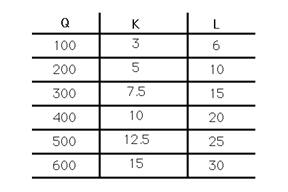
31) The table in Figure 6.3 shows the levels of output resulting from different levels of inputs. Which of the following conclusions can be drawn from this information?
A) Increasing returns to scale exist when 100 units of output are produced.
B) Constant returns to scale exist throughout all levels of production.
C) Labor is subject to diminishing marginal productivity in the short run.
D) No firm conclusions can be drawn.
Answer: A
Diff: 1
Topic: Returns to Scale
32) The table in Figure 6.3 shows the levels of output resulting from different levels of inputs. Returns to scale are greatest at which level of output?
A) 100 - 200 units
B) 200 - 400 units
C) 400 - 600 units
D) There is insufficient information to answer the question.
Answer: A
Diff: 1
Topic: Returns to Scale
33) The table in Figure 6.3 shows the levels of output resulting from different levels of inputs. At which level of input are there constant returns to scale?
A) 400 - 600 units
B) Constant returns to scale exist throughout all levels of production.
C) Constant returns to scale do not exist at any level of production.
D) No firm conclusions can be drawn.
Answer: A
Diff: 1
Topic: Returns to Scale
34) Suppose the production of VCRs can be represented by the following production function: q = L0.4 K0.4. Which of the following statements is (are) TRUE?
A) The production function has decreasing returns to scale.
B) The marginal productivity of labor falls as labor increases in the short run.
C) Capital and labor can be substituted for one another.
D) All of the above.
Answer: D
Diff: 2
Topic: Returns to Scale
35) Suppose the production of VCRs can be represented by the following production function: q = L0.4 K0.4. Which of the following statements is TRUE?
A) The production function has decreasing returns to scale.
B) The production function has increasing returns to scale.
C) The production function has constant returns to scale.
D) Returns to scale vary with the level of output.
Answer: A
Diff: 2
Topic: Returns to Scale
36) Suppose the production of VCRs can be represented by the following production function: q = L0.4 K0.4. The firm currently produces q1 units. If all inputs doubled, the new level of output will equal
A) 20.4 q1.
B) 20.8 q1.
C) 0.8 q1.
D) 1.6 q1.
Answer: B
Diff: 2
Topic: Returns to Scale
37) Returns to scale is a concept that operates
A) only in the short run.
B) only in the long run.
C) in both the long run and the short run.
D) in either the long run or the short run but never both.
Answer: B
Diff: 1
Topic: Returns to Scale
Figure 6.4
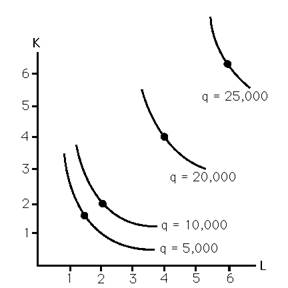
38) Figure 6.4 shows the isoquants for producing steel. Increasing returns to scale are
A) present when producing less than 10,000 tons.
B) present when producing less than 20,000 tons.
C) present when producing less than 30,000 tons.
D) never present.
Answer: A
Diff: 1
Topic: Returns to Scale
39) Figure 6.4 shows the isoquants for producing steel. Decreasing returns to scale are
A) present when producing more than 10,000 tons.
B) present when producing more than 20,000 tons.
C) present when producing more than 30,000 tons.
D) never present.
Answer: B
Diff: 1
Topic: Returns to Scale
40) Figure 6.4 shows the isoquants for producing steel. Constant returns to scale are
A) present when producing less than 10,000 tons.
B) present when producing between 10,000 and 20,000 tons.
C) present when producing more than 20,000 tons.
D) never present.
Answer: B
Diff: 1
Topic: Returns to Scale
41) Figure 6.4 shows the isoquants for producing steel. When producing more than 20,000 tons there are
A) increasing returns to scale.
B) decreasing returns to scale.
C) constant returns to scale.
D) economies of scale.
Answer: B
Diff: 1
Topic: Returns to Scale
42) Figure 6.4 shows the isoquants for producing steel. When producing less than 10,000 tons there are
A) increasing returns to scale.
B) decreasing returns to scale.
C) constant returns to scale.
D) diseconomies of scale.
Answer: A
Diff: 1
Topic: Returns to Scale
43) Figure 6.4 shows the isoquants for producing steel. When producing between 10,000 and 20,000 tons there are
A) increasing returns to scale.
B) decreasing returns to scale.
C) constant returns to scale.
D) economies of scale.
Answer: C
Diff: 1
Topic: Returns to Scale
44) The returns to scale of the production function Q = 50 L.4K.2 are
Answer: B
Diff: 1
Topic: Returns to Scale
45) Joey's lawncutting service recently traded in its push mowers for gasoline-powered mowers. Joey still requires one worker per lawnmower; however, more grass is now cut in the same amount of time as before. This is an example of
A) labor-saving technical change.
B) non-neutral technical change.
C) neutral technical change.
D) organizational change.
Answer: C
Diff: 1
Topic: Productivity and Technical Change
46) Suppose the production function for a certain device is q = L + K. If a labor-saving technical change has occurred, which of the following could be the new production function?
A) q = L + 5K
B) q = 5 * (L + K)
C) q = 5L + K
D) All of the above are possible.
Answer: A
Diff: 1
Topic: Productivity and Technical Change
47) Suppose the production function for a certain device is q = L + K. If neutral technical change has occurred, which of the following could be the new production function?
A) q = L + 5K
B) q = 5 * (L + K)
C) q = 5L + K
D) All of the above are possible.
Answer: B
Diff: 1
Topic: Productivity and Technical Change
48) Albert's Pretzel Baking Company used to have four workers who were each in charge of making their own pretzels from start to finish. Now, one worker mixes the dough, another shapes it, the third puts the unbaked pretzels into the oven and the fourth removes the finished product. Output has doubled. This is an example of
A) neutral technical change.
B) labor-saving technical change.
C) an organizational innovation.
D) economies of scale.
Answer: C
Diff: 1
Topic: Productivity and Technical Change
49) Over a five-year span, the ABC Co. reduced the amount of labor it hired. At the same time, the marginal productivity of labor increased. Which of the following COULD explain this observation?
A) the law of diminishing marginal returns
B) labor saving technical change
C) organizational innovation
D) All of the above.
Answer: D
Diff: 1
Topic: Productivity and Technical Change
TRUE/FALSE/EXPLAIN QUESTIONS
1) Were it not for the law of diminishing marginal returns, we could grow the world's food supply from a flowerpot.
Answer: True. Given the current state of technology, the law of diminishing marginal returns limits the amount of additional output yielded from additional labor working the flowerpot. Revoking the "law" would allow output to increase at a non-decreasing rate when more labor is applied to the flowerpot.
Diff: 2
Topic: Short-Run Production
2) The actual time length of the short run is determined by when diminishing marginal returns start.
Answer: False. The actual time length of the short run is a function of how long it would take to adjust all inputs.
Diff: 2
Topic: Short-Run Production
3) If marginal productivity is decreasing as more labor is hired, then average productivity must be decreasing as well.
Answer: False. The change in average productivity is not determined by the change in marginal productivity. Average productivity can be increasing even when marginal productivity is decreasing. Average productivity can only be decreasing when marginal productivity is below average productivity.
Diff: 1
Topic: Short-Run Production
4) Unlike indifference curves, isoquants can intersect.
Answer: False. By the same logic as with indifference curves, the intersection implies the same level of output. Since output increases as one moves toward the northeast on the isoquant map, moving from the intersection one isoquant shows higher output and the other shows lower. This is contradictory.
Diff: 1
Topic: Long-Run Production
5) Cobb-Douglas production functions can never possess varying returns to scale.
Answer: True. The Cobb-Douglas function takes the form q = La Kb, where the exponents are constant parameters. The returns to scale equals a + b which is constant for all q.
Diff: 1
Topic: Returns to Scale
PROBLEMS
1) At low levels of production, marginal productivity of labor increases as labor increases. At high levels of production, marginal productivity of labor decreases as labor increases. Are these two statements contradictory? Explain.
Answer: No. At low levels of production, marginal productivity of labor can increase due to specialization. Eventually, however, diminishing marginal productivity will commence.
Diff: 1
Topic: Short-Run Production
2) Explain the difference between diminishing returns to labor and diminishing
marginal returns to labor.
Answer: Diminishing returns to labor means that an increase in the number of labor units will decrease the amount of output. Diminishing marginal returns means that additional units of labor increase output at a decreasing rate.
Diff: 1
Topic: Short-Run Production
3) Each additional worker produces two extra units of output until the first three
units are produced for some production function. After the third unit is produced each additional worker produces one extra unit of output. What are the total product of labor, average product of labor and marginal product of labor for the first five units of production associated with this production function?
Answer:
Number of Workers TP AP MP
1 2 2 2
2 4 2 2
3 6 2 2
4 7 7/4 1
5 8 8/5 1
Diff:1
Topic: Short-Run Production
4) Consider the following short-run production function:
q = 5L2 - 1/3 L3. At what level of L do diminishing marginal returns begin? At what level of L do diminishing returns begin?
Answer: MP = 10L - L2. Marginal product peaks when L = 5 and equals zero when L = 10. Thus, diminishing marginal returns begin when L = 5, and diminishing returns begin when L = 10.
Diff: 2
Topic: Short-Run Production
5) Describe the relationship between marginal productivity and average productivity. Use calculus or a graph to support your answer.
Answer: AP = Q(L)/L. dAP/dL = [L * MP] - Q /L2 = MP - AP/L. Thus, if MP = AP, AP is constant. If MP > AP, AP will rise. If MP < AP, AP will fall.
Diff: 1
Topic: Short-Run Production
6) Suppose the production function for T-shirts can be represented as q = L0.25 K0.75. Show that the marginal productivity of labor diminishes in the short run.
Answer: In the short run, MPL= 0.25 * (q/L). The change in MP with respect to L equals d(MP)/dL = -0.25 * q / L2. Thus, for all levels of labor hired, MP falls as L increases.
Diff: 2
Topic: Short-Run Production
7) Suppose that additional units of capital affect the marginal productivity of labor. This is not unrealistic. Word processors increase the marginal productivity of secretaries. On the other hand, robotic equipment can completely replace a worker and, thereby, lower the marginal productivity of labor. Given this possibility, determine the conditions under which isoquants will not be convex (i.e.: concave).
Answer: The slope of the isoquant equals -MPL/MPK. To be concave, the slope of the isoquant becomes steeper as L increases. For this to be the case, MPL would have to increase more than MPK as labor increases and capital falls. That means the decrease in capital causes MPL to rise more than the increase in labor causes MPL to fall. The large inverse relationship implies that capital is replacing labor for this to be the case.
Diff: 2
Topic: Long-Run Production
8) Suppose the production function for T-shirts can be represented as q = L0.25 K0.75. Show that the isoquants for this function are convex.
Answer: The slope of the isoquant is -MPL/MPK = -K/3L. As L increases and K decreases, this value becomes absolutely smaller implying a flatter slope.
Diff: 2
Topic: Long-Run Production
9) Suppose the production function for T-shirts can be represented as q = L0.25 K0.75. When K = 1 and q =2, what is the slope of the isoquant? If there is insufficient information to answer the question, describe what information is needed.
Answer: Since the slope of the isoquant is -K/3L, one needs to know the level of L. Since K = 1 and q = 2, L must equal 16. Thus, the slope of the isoquant at this point is
-(1/48).
Diff: 2
Topic: Long-Run Production
10) Show that increasing returns to scale can co-exist with diminishing marginal productivity.
Answer: The production function below illustrates this point. Diminishing marginal productivity describes what happens to output when only labor increases; returns to scale describes what happens to output when both capital and labor increase.
q L K
110 10 10
112 11 10
113 12 10
140 12 12
The first three rows illustrate diminishing marginal returns. Comparing rows 1 and 4 shows increasing returns to scale.
Diff: 2
Topic: Returns to Scale
11) Suppose the production function for T-shirts can be represented as q = L0.25 K0.75. Show that the production function has constant returns to scale.
Answer: When L = L1 and K = K1, q = q1. Let L2 = lL1 and K2 = lK1 so that both L and K have increased by the same proportion.
Then , q2 = lL10.25 lK10.75 = l0.25+0.75L10.25K10.75 = lq1. Thus, for any l, output changes by the same proportion that the inputs changed.
Diff: 2
Topic: Returns to Scale
Figure 6.5
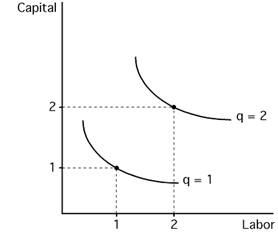
12) Provide a graph and an explanation to show that the production function Q = L.5K.5 has diminishing marginal product of labor but has constant returns to scale.
Answer: See Figure 6.5. The MPL = .5*L-.5K.5 so as the amount of labor increases the MPL falls. The convex shape of the isoquants illustrates the diminishing marginal product of labor. Doubling both capital and labor will result in output doubling.
Diff: 2
Topic: Returns to Scale
Figure 6.4
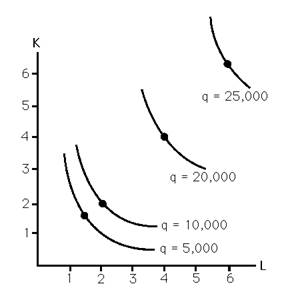
13) Figure 6.4 shows the isoquants for the production of steel. In which regions of production are there increasing, decreasing, and constant returns to scale?
Answer: When output is less than 10,000 tons, there are increasing returns to scale. Between 10,000 and 20,000 tons, there are constant returns to scale. For output greater than 20,000 tons, there are decreasing returns to scale.
Diff: 1
Topic: Returns to Scale
14) Suppose firms A and B each make T-shirts. Firm A's production function is q = L0.5 K0.5. Firm B's production function is q = 1.2* L0.5 K0.5. If the two firms each hire the same amounts of capital and labor, compare the two firms in terms of APL and MPL.
Answer: Firm B's APL and MPL will equal 1.2 times the APL and MPL of firm A.
Diff: 2
Topic: Productivity and Technical Change
Figure 6.6
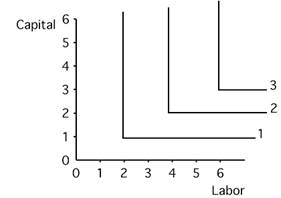
15) Production occurs using the fixed-proportion combination of two workers for every
one unit of capital. Draw the isoquants for this production function. After one unit of output is produced, does this production function exhibit constant, increasing, or decreasing returns to scale?
Answer: See Figure 6.6. The production function exhibits constant returns to scale
Diff: 2
Topic: Returns to Scale
Source: http://static.gest.unipd.it/~birolo/didattica08/materiale07/materiale_Perloff/testbank-1/tbch06.doc
Web site to visit: http://static.gest.unipd.it
Author of the text: not indicated on the source document of the above text
If you are the author of the text above and you not agree to share your knowledge for teaching, research, scholarship (for fair use as indicated in the United States copyrigh low) please send us an e-mail and we will remove your text quickly. Fair use is a limitation and exception to the exclusive right granted by copyright law to the author of a creative work. In United States copyright law, fair use is a doctrine that permits limited use of copyrighted material without acquiring permission from the rights holders. Examples of fair use include commentary, search engines, criticism, news reporting, research, teaching, library archiving and scholarship. It provides for the legal, unlicensed citation or incorporation of copyrighted material in another author's work under a four-factor balancing test. (source: http://en.wikipedia.org/wiki/Fair_use)
The information of medicine and health contained in the site are of a general nature and purpose which is purely informative and for this reason may not replace in any case, the council of a doctor or a qualified entity legally to the profession.
The following texts are the property of their respective authors and we thank them for giving us the opportunity to share for free to students, teachers and users of the Web their texts will used only for illustrative educational and scientific purposes only.
All the information in our site are given for nonprofit educational purposes
The information of medicine and health contained in the site are of a general nature and purpose which is purely informative and for this reason may not replace in any case, the council of a doctor or a qualified entity legally to the profession.
www.riassuntini.com